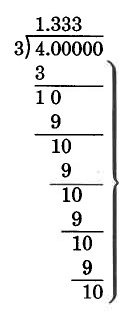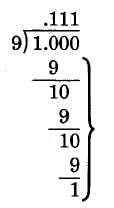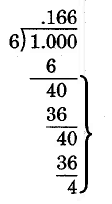6.7: Nonterminating Divisions
- Page ID
- 52601
\( \newcommand{\vecs}[1]{\overset { \scriptstyle \rightharpoonup} {\mathbf{#1}} } \)
\( \newcommand{\vecd}[1]{\overset{-\!-\!\rightharpoonup}{\vphantom{a}\smash {#1}}} \)
\( \newcommand{\dsum}{\displaystyle\sum\limits} \)
\( \newcommand{\dint}{\displaystyle\int\limits} \)
\( \newcommand{\dlim}{\displaystyle\lim\limits} \)
\( \newcommand{\id}{\mathrm{id}}\) \( \newcommand{\Span}{\mathrm{span}}\)
( \newcommand{\kernel}{\mathrm{null}\,}\) \( \newcommand{\range}{\mathrm{range}\,}\)
\( \newcommand{\RealPart}{\mathrm{Re}}\) \( \newcommand{\ImaginaryPart}{\mathrm{Im}}\)
\( \newcommand{\Argument}{\mathrm{Arg}}\) \( \newcommand{\norm}[1]{\| #1 \|}\)
\( \newcommand{\inner}[2]{\langle #1, #2 \rangle}\)
\( \newcommand{\Span}{\mathrm{span}}\)
\( \newcommand{\id}{\mathrm{id}}\)
\( \newcommand{\Span}{\mathrm{span}}\)
\( \newcommand{\kernel}{\mathrm{null}\,}\)
\( \newcommand{\range}{\mathrm{range}\,}\)
\( \newcommand{\RealPart}{\mathrm{Re}}\)
\( \newcommand{\ImaginaryPart}{\mathrm{Im}}\)
\( \newcommand{\Argument}{\mathrm{Arg}}\)
\( \newcommand{\norm}[1]{\| #1 \|}\)
\( \newcommand{\inner}[2]{\langle #1, #2 \rangle}\)
\( \newcommand{\Span}{\mathrm{span}}\) \( \newcommand{\AA}{\unicode[.8,0]{x212B}}\)
\( \newcommand{\vectorA}[1]{\vec{#1}} % arrow\)
\( \newcommand{\vectorAt}[1]{\vec{\text{#1}}} % arrow\)
\( \newcommand{\vectorB}[1]{\overset { \scriptstyle \rightharpoonup} {\mathbf{#1}} } \)
\( \newcommand{\vectorC}[1]{\textbf{#1}} \)
\( \newcommand{\vectorD}[1]{\overrightarrow{#1}} \)
\( \newcommand{\vectorDt}[1]{\overrightarrow{\text{#1}}} \)
\( \newcommand{\vectE}[1]{\overset{-\!-\!\rightharpoonup}{\vphantom{a}\smash{\mathbf {#1}}}} \)
\( \newcommand{\vecs}[1]{\overset { \scriptstyle \rightharpoonup} {\mathbf{#1}} } \)
\( \newcommand{\vecd}[1]{\overset{-\!-\!\rightharpoonup}{\vphantom{a}\smash {#1}}} \)
\(\newcommand{\avec}{\mathbf a}\) \(\newcommand{\bvec}{\mathbf b}\) \(\newcommand{\cvec}{\mathbf c}\) \(\newcommand{\dvec}{\mathbf d}\) \(\newcommand{\dtil}{\widetilde{\mathbf d}}\) \(\newcommand{\evec}{\mathbf e}\) \(\newcommand{\fvec}{\mathbf f}\) \(\newcommand{\nvec}{\mathbf n}\) \(\newcommand{\pvec}{\mathbf p}\) \(\newcommand{\qvec}{\mathbf q}\) \(\newcommand{\svec}{\mathbf s}\) \(\newcommand{\tvec}{\mathbf t}\) \(\newcommand{\uvec}{\mathbf u}\) \(\newcommand{\vvec}{\mathbf v}\) \(\newcommand{\wvec}{\mathbf w}\) \(\newcommand{\xvec}{\mathbf x}\) \(\newcommand{\yvec}{\mathbf y}\) \(\newcommand{\zvec}{\mathbf z}\) \(\newcommand{\rvec}{\mathbf r}\) \(\newcommand{\mvec}{\mathbf m}\) \(\newcommand{\zerovec}{\mathbf 0}\) \(\newcommand{\onevec}{\mathbf 1}\) \(\newcommand{\real}{\mathbb R}\) \(\newcommand{\twovec}[2]{\left[\begin{array}{r}#1 \\ #2 \end{array}\right]}\) \(\newcommand{\ctwovec}[2]{\left[\begin{array}{c}#1 \\ #2 \end{array}\right]}\) \(\newcommand{\threevec}[3]{\left[\begin{array}{r}#1 \\ #2 \\ #3 \end{array}\right]}\) \(\newcommand{\cthreevec}[3]{\left[\begin{array}{c}#1 \\ #2 \\ #3 \end{array}\right]}\) \(\newcommand{\fourvec}[4]{\left[\begin{array}{r}#1 \\ #2 \\ #3 \\ #4 \end{array}\right]}\) \(\newcommand{\cfourvec}[4]{\left[\begin{array}{c}#1 \\ #2 \\ #3 \\ #4 \end{array}\right]}\) \(\newcommand{\fivevec}[5]{\left[\begin{array}{r}#1 \\ #2 \\ #3 \\ #4 \\ #5 \\ \end{array}\right]}\) \(\newcommand{\cfivevec}[5]{\left[\begin{array}{c}#1 \\ #2 \\ #3 \\ #4 \\ #5 \\ \end{array}\right]}\) \(\newcommand{\mattwo}[4]{\left[\begin{array}{rr}#1 \amp #2 \\ #3 \amp #4 \\ \end{array}\right]}\) \(\newcommand{\laspan}[1]{\text{Span}\{#1\}}\) \(\newcommand{\bcal}{\cal B}\) \(\newcommand{\ccal}{\cal C}\) \(\newcommand{\scal}{\cal S}\) \(\newcommand{\wcal}{\cal W}\) \(\newcommand{\ecal}{\cal E}\) \(\newcommand{\coords}[2]{\left\{#1\right\}_{#2}}\) \(\newcommand{\gray}[1]{\color{gray}{#1}}\) \(\newcommand{\lgray}[1]{\color{lightgray}{#1}}\) \(\newcommand{\rank}{\operatorname{rank}}\) \(\newcommand{\row}{\text{Row}}\) \(\newcommand{\col}{\text{Col}}\) \(\renewcommand{\row}{\text{Row}}\) \(\newcommand{\nul}{\text{Nul}}\) \(\newcommand{\var}{\text{Var}}\) \(\newcommand{\corr}{\text{corr}}\) \(\newcommand{\len}[1]{\left|#1\right|}\) \(\newcommand{\bbar}{\overline{\bvec}}\) \(\newcommand{\bhat}{\widehat{\bvec}}\) \(\newcommand{\bperp}{\bvec^\perp}\) \(\newcommand{\xhat}{\widehat{\xvec}}\) \(\newcommand{\vhat}{\widehat{\vvec}}\) \(\newcommand{\uhat}{\widehat{\uvec}}\) \(\newcommand{\what}{\widehat{\wvec}}\) \(\newcommand{\Sighat}{\widehat{\Sigma}}\) \(\newcommand{\lt}{<}\) \(\newcommand{\gt}{>}\) \(\newcommand{\amp}{&}\) \(\definecolor{fillinmathshade}{gray}{0.9}\)- understand the meaning of a nonterminating division
- be able to recognize a nonterminating number by its notation
Nonterminating Divisions
Let's consider two divisions:
\(9.8 \div 3.5\)
\(4 \div 3\)
Previously, we have considered divisions like example, which is an example of a terminating division. A terminating division is a division in which the quotient terminates after several divisions (the remainder is zero).

The quotient in this problem terminates in the tenths position. Terminating divisions are also called exact divisions.
The division in example is an example of a nonterminating division. A non-terminating division is a division that, regardless of how far we carry it out, always has a remainder.

We can see that the pattern in the brace is repeated endlessly. Such a decimal quotient is called a repeating decimal.
Denoting Nonterminating Quotients
We use three dots at the end of a number to indicate that a pattern repeats itself endlessly.
\[4 \div 3 = 1.333... \nonumber\]
Another way, aside from using three dots, of denoting an endlessly repeating pattern is to write a bar ( ¯ ) above the repeating sequence of digits.
\[4 \div 3 = 1.\bar{3} \nonumber\]
The bar indicates the repeated pattern of 3.
Repeating patterns in a division can be discovered in two ways:
As the division process progresses, should the remainder ever be the same as the dividend, it can be concluded that the division is nonterminating and that the pattern in the quotient repeats. This fact is illustrated in Example of Sample Set A.
As the division process progresses, should the "product, difference" pattern ever repeat two consecutive times, it can be concluded that the division is nonterminating and that the pattern in the quotient repeats. This fact is illustrated in Example and 4 of Sample Set A.
Carry out each division until the repeating pattern can be determined.
\(100 \div 27\)
Solution
\(\begin{array} {r} {3.70370} \\ {27 \overline{)100.00000}} \\ {\underline{81\ \ \ \ \ \ \ \ \ \ \ }} \\ {19\ 0\ \ \ \ \ \ \ \ } \\ {\underline{18\ 9\ \ \ \ \ \ \ \ }} \\ {100\ \ \ \ } \\ {\underline{81\ \ \ \ }} \\ {190\ \ } \\ {189\ \ } \end{array}\)
When the remainder is identical to the dividend, the division is nonterminating. This implies that the pattern in the quotient repeats.
\(100 \div 27 = 3.70370370...\) The repeating block is 703.
\(100 \div 27 = 3.\overline{703}\)
\(1 \div 9\)
Solution

We see that this “product, difference”pattern repeats. We can conclude that the division is nonterminating and that the quotient repeats.
\(1 \div 9 = 0.111...\) The repeating block is 1.
\(1 \div 9 = 0.\overline{1}\)
Divide 2 by 11 and round to 3 decimal places.
Solution
Since we wish to round the quotient to three decimal places, we'll carry out the division so that the quotient has four decimal places.
\(\begin{array} {r} {.1818} \\ {11 \overline{)2.0000}} \\ {\underline{1.1\ \ \ \ \ \ }} \\ {90\ \ \ \ } \\ {\underline{88\ \ \ \ }} \\ {20\ \ } \\ {\underline{11\ \ }} \\ {90} \end{array}\)
The number .1818 rounded to three decimal places is .182. Thus, correct to three decimal places,
\(2 \div 11 = 0.182\)
Divide 1 by 6.
Solution

We see that this “product, difference” pattern repeats. We can conclude that the division is nonterminating and that the quotient repeats at the 6.
\(1 \div 6 = 0.16\overline{6}\)
Practice Set A
Carry out the following divisions until the repeating pattern can be determined.
\(1 \div 3\)
- Answer
-
\(0.\overline{3}\)
Practice Set A
\(5 \div 6\)
- Answer
-
\(0.8\overline{3}\)
Practice Set A
\(11 \div 9\)
- Answer
-
\(1.\overline{2}\)
Practice Set A
\(17 \div 9\)
- Answer
-
\(1.\overline{8}\)
Practice Set A
Divide 7 by 6 and round to 2 decimal places.
- Answer
-
1.17
Practice Set A
Divide 400 by 11 and round to 4 decimal places.
- Answer
-
36.3636
Exercises
For the following 20 problems, carry out each division until the repeating pattern is determined. If a repeating pattern is not apparent, round the quotient to three decimal places.
Exercise \(\PageIndex{1}\)
\(4 \div 9\)
- Answer
-
\(0.\overline{4}\)
Exercise \(\PageIndex{2}\)
\(8 \div 11\)
Exercise \(\PageIndex{3}\)
\(4 \div 25\)
- Answer
-
0.16
Exercise \(\PageIndex{4}\)
\(5 \div 6\)
Exercise \(\PageIndex{5}\)
\(1 \div 7\)
- Answer
-
\(0.\overline{142857}\)
Exercise \(\PageIndex{6}\)
\(3 \div 1.1\)
Exercise \(\PageIndex{7}\)
\(20 \div 1.9\)
- Answer
-
10.526
Exercise \(\PageIndex{8}\)
\(10 \div 2.7\)
Exercise \(\PageIndex{9}\)
\(1.11 \div 9.9\)
- Answer
-
\(0.1\overline{12}\)
Exercise \(\PageIndex{10}\)
\(8.08 \div 3.1\)
Exercise \(\PageIndex{11}\)
\(51 \div 8.2\)
- Answer
-
\(6.\overline{21951}\)
Exercise \(\PageIndex{12}\)
\(0.213 \div 0.31\)
Exercise \(\PageIndex{13}\)
\(0.009 \div 1.1\)
- Answer
-
\(0.00\overline{81}\)
Exercise \(\PageIndex{14}\)
\(6.03 \div 1.9\)
Exercise \(\PageIndex{15}\)
\(0.518 \div 0.62\)
- Answer
-
0.835
Exercise \(\PageIndex{16}\)
\(1.55 \div 0.27\)
Exercise \(\PageIndex{17}\)
\(0.333 \div 0.999\)
- Answer
-
\(0.\overline{3}\)
Exercise \(\PageIndex{18}\)
\(0.444 \div 0.999\)
Exercise \(\PageIndex{19}\)
\(0.555 \div 0.27\)
- Answer
-
\(2.0\overline{5}\)
Exercise \(\PageIndex{20}\)
\(3.8 \div 0.99\)
Calculator Problems
For the following 10 problems, use a calculator to perform each division.
Exercise \(\PageIndex{21}\)
\(7 \div 9\)
- Answer
-
\(0.\overline{7}\)
Exercise \(\PageIndex{22}\)
\(8 \div 11\)
Exercise \(\PageIndex{23}\)
\(14 \div 27\)
- Answer
-
\(0.\overline{518}\)
Exercise \(\PageIndex{24}\)
\(1 \div 44\)
Exercise \(\PageIndex{25}\)
\(2 \div 44\)
- Answer
-
\(0.0\overline{45}\)
Exercise \(\PageIndex{26}\)
\(0.7 \div 0.9\) (Compare this with Exercise above)
Exercise \(\PageIndex{27}\)
\(80 \div 110\) (Compare this with Exercise above)
- Answer
-
\(0.\overline{72}\)
Exercise \(\PageIndex{28}\)
\(0.0707 \div 0.7070\)
Exercise \(\PageIndex{29}\)
\(0.1414 \div 0.2020\)
- Answer
-
0.7
Exercise \(\PageIndex{30}\)
\(1 \div 0.9999999\)
Exercise for Review
Exercise \(\PageIndex{31}\)
In the number 411,105, how many ten thousands are there?
- Answer
-
1
Exercise \(\PageIndex{32}\)
Find the quotient, if it exists. \(17 \div 0\).
Exercise \(\PageIndex{33}\)
Find the least common multiple of 45, 63, and 98.
- Answer
-
4410
Exercise \(\PageIndex{34}\)
Subtract 8.01629 from 9.00187 and round the result to three decimal places.
Exercise \(\PageIndex{35}\)
Find the quotient. \(104.06 \div 12.1\).
- Answer
-
8.6

